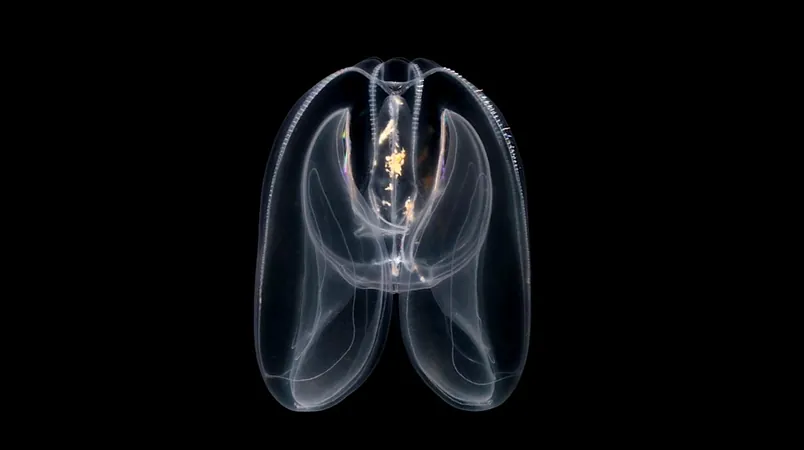
Unlocking the Past: Comb Jellies Unveil Ancient Gene Control Mechanisms
2025-05-08
Author: Rajesh
In the intricate world of life on Earth, genes are the ultimate conductors, orchestrating when to act and when to remain silent. Even the tiniest organisms exhibit this remarkable ability—usually keeping it simple with switches located right next to the genes they regulate. However, a groundbreaking study sheds light on a more sophisticated layer of gene regulation that dates back nearly 700 million years!
Published in the prestigious journal Nature, researchers from the Centre for Genomic Regulation (CRG) and the Centre Nacional d’Anàlisi Genòmica (CNAG) have discovered that long-distance gene control, known as distal regulation, emerged at the very dawn of animal evolution. This transformative ability appeared about 150 million years earlier than previously thought, marking a significant milestone in the history of life.
The Power of Distal Regulation
So, what exactly is distal regulation? It involves the intricate folding of DNA into sophisticated loops, allowing segments far removed from a gene’s starting point to activate its expression. This innovative mechanism likely played a crucial role in helping early multicellular organisms develop specialized cell types and tissues without needing to invent new genes.
The origin of this groundbreaking gene control is believed to be a sea creature—the common ancestor of all existing animals. This primordial being had the extraordinary capability to manipulate DNA into loops, effectively bringing distant sections of DNA into close contact.
Unexpected Findings from the Deep
Dr. Iana Kim, the study's lead author, commented, "This creature could repurpose its genetic toolkit in different ways like a Swiss knife, opening up avenues for innovative survival strategies. The discovery of such a complex regulatory system being so ancient took us by surprise."
The study examined a variety of ancient animal branches, including fascinating creatures like comb jellies, placozoans, cnidarians, and even sponges. Through this extensive exploration, it became clear that weird sea creatures could unlock vast biological mysteries!
Cutting-Edge Techniques Reveal Genetic Secrets
Using advanced mapping techniques known as Micro-C, scientists were able to visualize how DNA is folded within the cells of 11 different species. For perspective, each human cell nucleus packs in approximately two meters of DNA! The team sifted through an astonishing 10 billion pieces of sequencing data to create intricate 3D genome maps.
Among these enigmatic creatures, the comb jelly was especially astonishing, boasting over 4,000 genomic loops despite having only 200 million DNA letters—far fewer compared to the 3.1 billion letters found in humans.
Shattering Assumptions About Gene Regulation
Previously, it was believed that distal regulation first emerged in the last common ancestor of bilateral animals about 500 million years ago. This new research pushes that timeline back, demonstrating that comb jellies, which branched off earlier from other animal lineages, utilized distal regulation long before.
In another surprising twist, the study highlighted that while many vertebrates rely on a protein called CTCF for loop formation, early-branching creatures do not possess this protein. Instead, comb jellies utilize a different component from the same structural family, challenging the notion that sophisticated gene architecture is uniformly dependent on CTCF.
Implications for Modern Biology
The revelation that mechanisms of gene regulation were established so long ago offers fresh insights into the fundamental rules that govern cellular functions today. Distal regulation is crucial for generating a variety of cell types—from neurons to immune cells—and understanding its ancient origins could pave the way for new medical breakthroughs.
As researchers continue to unravel these long-hidden secrets of the genetic code, the implications extend far beyond evolutionary biology. This research highlights the marvels of evolution and reminds us that the building blocks of life—like DNA—have been shaping organisms for millions of years.
This remarkable study is a collaboration involving several institutions, including the CRG, CNAG, University of Bergen, Queen Mary University of London, Prefectural University of Hiroshima, and the University of Alberta, underscoring the collective quest to understand our biological heritage.




 Brasil (PT)
Brasil (PT)
 Canada (EN)
Canada (EN)
 Chile (ES)
Chile (ES)
 Česko (CS)
Česko (CS)
 대한민국 (KO)
대한민국 (KO)
 España (ES)
España (ES)
 France (FR)
France (FR)
 Hong Kong (EN)
Hong Kong (EN)
 Italia (IT)
Italia (IT)
 日本 (JA)
日本 (JA)
 Magyarország (HU)
Magyarország (HU)
 Norge (NO)
Norge (NO)
 Polska (PL)
Polska (PL)
 Schweiz (DE)
Schweiz (DE)
 Singapore (EN)
Singapore (EN)
 Sverige (SV)
Sverige (SV)
 Suomi (FI)
Suomi (FI)
 Türkiye (TR)
Türkiye (TR)
 الإمارات العربية المتحدة (AR)
الإمارات العربية المتحدة (AR)